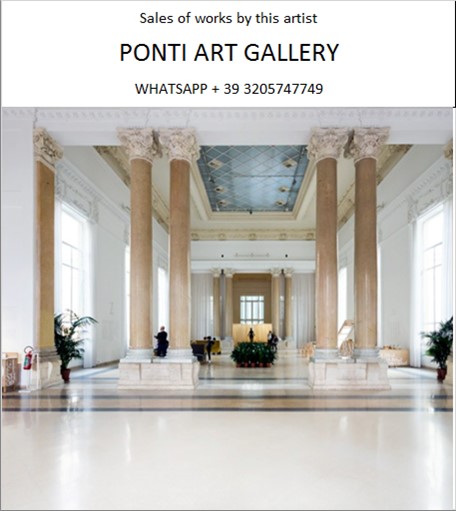Ponti Art Gallery is interested in buying and selling works
of art by this artist.

Felice Casorati Biography
Felice Casorati was a distinguished Italian painter, sculptor, and printmaker, whose work is celebrated for its unique compositions, portraits, and still lifes, often marked by unusual perspective effects. Born on December 4, 1883, in Novara, Italy, Casorati was born into a family known for its mathematicians, lawyers, and doctors. Despite the family's academic leanings, Casorati showed an early passion for music, but a serious illness during his youth led him to abandon his study of piano and turn his attention to art.
To satisfy his family's expectations, Casorati pursued legal studies and graduated in law from the University of Padua in 1906. However, his true ambition was to become a painter, a dream that was confirmed when his work was exhibited at the Venice Biennale in 1907. This marked the beginning of his artistic career, which initially showcased a naturalistic style.
Casorati's early paintings were influenced by the Symbolist movement and the Vienna Secession, and after 1910, the work of Gustav Klimt had a significant impact on his artistic direction, steering him towards a more visionary approach. His participation in the Venice Biennale continued in 1909 and 1910, where he had the opportunity to observe Klimt's work firsthand. This experience influenced some of his later paintings, such as "The Dream of the Pomegranate," presented at the First International Art Exhibition of the Secession in Rome in 1913.
During the years 1911 to 1915, Casorati lived in Verona, where he co-founded the magazine "La Via Lattea" with other artists and contributed illustrations in the Art Nouveau style. His military service in World War I began in 1915 and lasted until his discharge after his father's death. In 1918, he settled in Turin, intrigued by its "decadent atmosphere" and "sinister views." It was here that his work began to typify the "return to order" movement, a post-war artistic trend that emphasized geometry and formal clarity as a reaction to the chaos of the war.
Casorati's work from the next decade is characterized by its emphasis on geometry and formal clarity, reflecting the "return to order" prevalent in the arts as a reaction to the war. His paintings often worked in tempera and drew inspiration from Renaissance masters, particularly Piero della Francesca, as seen in his 1922 portrait "Silvana Cenni." This symmetrical composition of a seated woman in a white dress is perhaps the best-known of the artist's works, where the careful rendering of volumes paradoxically results in a sense of unreality, a characteristic of Casorati's art that connects him to the metaphysical painters.
Despite a brief arrest in 1923 for his involvement with an anti-Fascist group, Casorati managed to avoid further antagonizing the regime. He opened his studio to young art students in Turin and emerging Italian artists, influencing the next generation of Italian painters. One of his famous students was the Italian painter Enrico Accatino.
After 1930, the severity of Casorati's earlier style softened, and his palette brightened. He continued to exhibit widely, winning many awards, including the First Prize at the Venice Biennale of 1938. His work "Carità di San Martino" (1939) is in the Museo cantonale d'arte of Lugano. Casorati was also involved in stage design, and his later students included the Italian painter Enrico Accatino.
Casorati's multifaceted non-pictorial activity is also noteworthy, including engraving, sculpture, mosaic, and theatrical set and costume design. He worked on various projects, such as polychrome heads at the Roman Secessions, friezes and statues for the Gualino theater, and mosaics for the Brussels Exhibition of 1934 and the VI Triennale of Milan in 1936. His theatrical set and costume designs were featured at the Maggio Musicale Fiorentino, Teatro alla Scala in Milan, Venice Festival, Eliseo in Rome, and the Piccolo Teatro in Milan.
Felice Casorati passed away in Turin on March 1, 1963. His legacy is preserved in Italian collections, both public and private, including the Modern Art Revoltella Museum in Trieste and Galleria Nazionale d'Arte Moderna. His work is also held in international museums such as the Museum of Fine Arts in Boston, the Detroit Institute of Arts, the Metropolitan Museum of Art, the Birmingham Museum of Art, the British Museum, MSK Ghent Belgium, and the University of Michigan Museum of Art.
Casorati's art, characterized by its intellectual rigor and classical references, played a significant role in the "return to order" in Italian painting and continues to be appreciated for its enigmatic and metaphysical qualities. His influence on Italian art and his contributions to various artistic disciplines make him a significant figure in the history of 20th-century art.
Felice Casorati Quotes and
Sales of Works
Ponti Art Gallery selects and deals with paintings by the
artist. Upon request, we provide free estimates and
evaluations, communicate prices, quotations, and current
market values.
If you are interested in BUYING or SELLING works by the
artist, contact us immediately.
If you wish to sell or receive an evaluation of the
works:
Send us a frontal photo of the painting, one of the back,
and one of the signature. Also, indicate the dimensions of
the work. Inform us about the purchase origin of the work
and any kind of available documentation (purchase
receipts, certificates of authenticity, publications). One
of our operators will respond to you on the same day. We
guarantee maximum confidentiality and extreme
professionalism.
If you wish to purchase works by the painter: Contact us
and let us know your request. We will inform you about the
available works. We also offer the possibility to
subscribe to our NEWSLETTER, through which you will be
informed at the beginning of each month about the latest
acquisitions of the art gallery.
You can send us pictures of the work:
